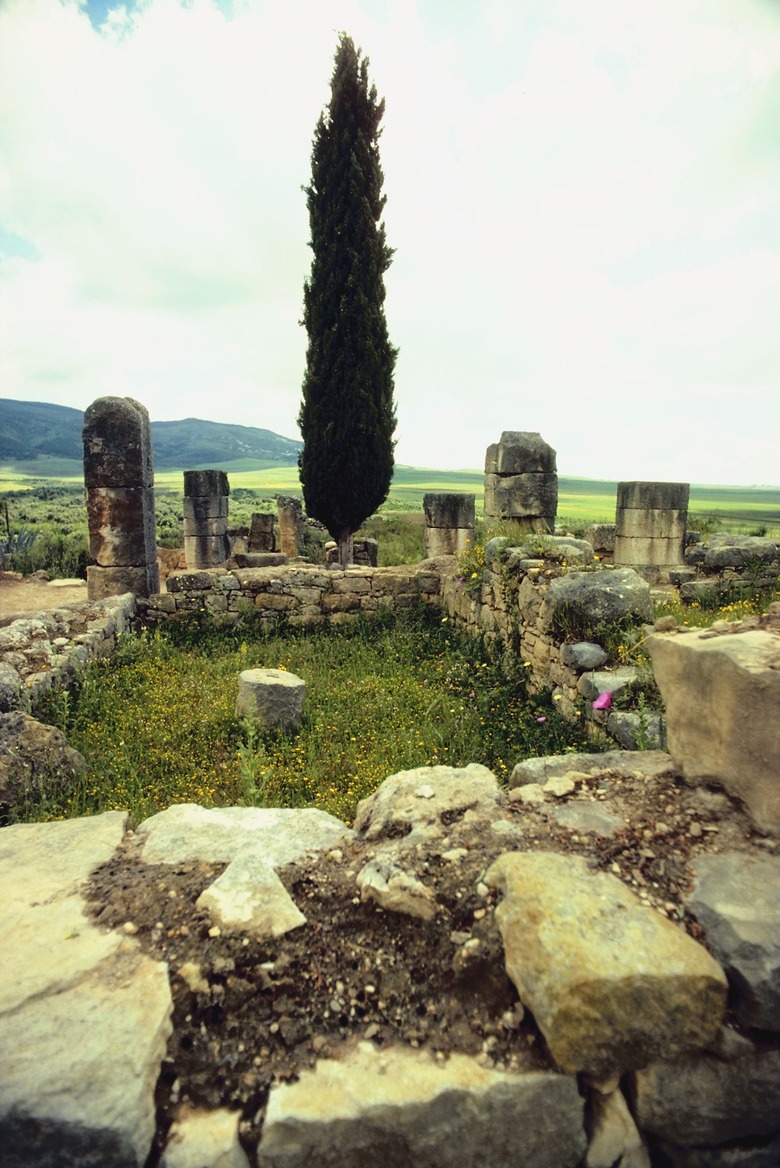Italian Cypress Substitute
Italian cypress trees (Cupressus sempervirens) provide the stately spires that are the hallmark of formal Italian gardens. Used for hedges, to line a driveway or as punctuation points in a landscape, they grow slowly to 70 feet tall, yet stay only about 10 feet wide. They don't grow in all climates and need summer heat and low humidity. While they grow in U.S. Department of Agriculture plant hardiness zones 7 through 10, in areas with cool summers, you may have better luck with a lookalike tree.
Junipers
Step 1
Tall, narrow junipers (Juniperus spp.) are hard to tell apart from Italian cypress, except that their foliage is more blue-green. They don't get as tall as cypress, so they're more suitable for urban areas. "Skyrocket" juniper (Juniperus scopulorum "Skyrocket") grows in USDA zones 4 through 9 and reaches 20 feet tall and 3 feet wide. "Blue Arrow" juniper (Juniperus virginiana "Blue Arrow") grows to 15 feet tall and 2 feet wide in USDA zones 4 through 9. Junipers can be slightly toxic and may cause skin irritation.
- Italian cypress trees (Cupressus sempervirens) provide the stately spires that are the hallmark of formal Italian gardens.
- While they grow in U.S. Department of Agriculture plant hardiness zones 7 through 10, in areas with cool summers, you may have better luck with a lookalike tree.
Arborvitae
Step 1
The bright green foliage and upright stance of arborvitae (Thuja occidentalis) makes it a good choice for the same uses as Italian cypress. It grows in USDA zones 4 through 8. "Emerald" (Thjua occidentalis "Emerald") is a deep green cultivar that grows 15 feet tall and 4 feet wide. "DeGroot's Spire" arborvitae (Thuja occidentalis "DeGroot's Spire") is a narrow, columnar tree that reaches about 10 feet tall by 2 feet wide.
Yew
Step 1
English or Irish yew (Taxus spp.) produce dense, upright growth and are one of the few conifers that will thrive in shade. "Fastigiata" yew (Taxus baccata "Fastigiata") grows in USDA zones 6 through 9 and reaches 8 feet tall. "Beanpole" yew (Taxus x media "Beanpole") grows 10 feet tall but only 1 foot wide and thrives in USDA zones 5 through 8. Most parts of yew are poisonous, so plant it only if you don't have curious children and pets.
- The bright green foliage and upright stance of arborvitae (Thuja occidentalis) makes it a good choice for the same uses as Italian cypress.
- DeGroot's Spire" arborvitae (Thuja occidentalis "DeGroot's Spire") is a narrow, columnar tree that reaches about 10 feet tall by 2 feet wide.
Holly and Boxwood
Step 1
Little-leaf hollies have small, oval leaves similar to those of boxwood. A columnar form, "Sky Pencil" holly (Ilex crenata "Sky Pencil") grows 8 feet tall and 2 to 3 feet wide in USDA zones 5 through 9. "Graham Blandy" boxwood (Buxus sempervirens "Graham Blandy") becomes an 8-foot tall, 2-foot-wide pillar in 15 years and is hardy in USDA zones 6 through 8. Both holly and boxwood are slightly toxic if eaten.
References
- Christian Science Monitor: For a Waterwise Landscape, Consider Mediterranean Garden Design
- Missouri Botanical Garden: Cupressus Sempervirens
- Monrovia: "Skyrocket" Juniper
- Monrovia: "Blue Arrow" Juniper
- North Carolina State University Extension: Thuja Occidentalis "DeGroot's Spire"
- Monrovia: "Emerald" Arborvitae
- Great Plant Picks: Taxus Baccata "Fastigiata"
- Washington State University Clark County Extension: "Beanpole" Yew
- Monrovia: "Sky Pencil" Japanese Holly
- Virginia State University: Selecting Landscape Plants: Boxwood
